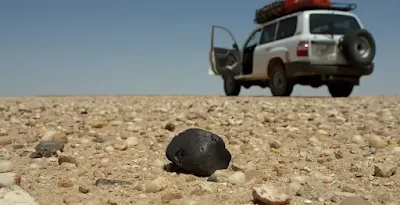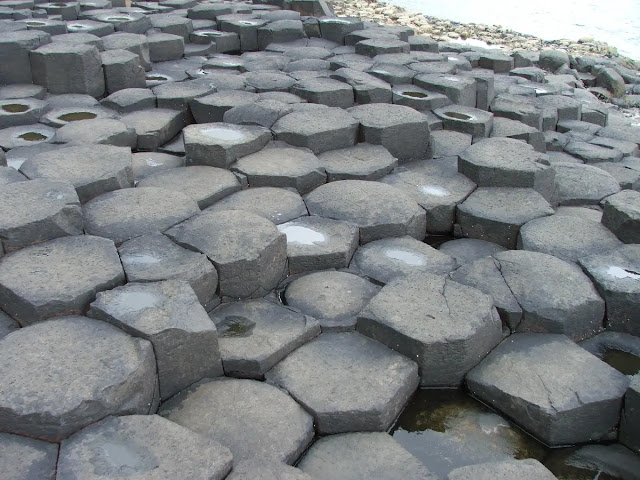Meteorite: What is a Meteorite, Definition, Composition
What is a Meteorite
Meteorite is a rock from space. It starts as a chunk of a larger object, like an asteroid or comet, that breaks apart. When a piece falls towards Earth, the friction with our atmosphere heats it up, making it glow and often burning most of it away. This glowing streak of light is called a meteor, or "shooting star." However, some pieces are big and strong enough to survive and land on Earth's surface as a meteorite.
Most meteoroids burn up completely before reaching the ground, but some large ones survive and become meteorites. Meteorites can be a variety of sizes, from tiny pebbles to large boulders. The largest meteorite ever found on Earth is the Hoba meteorite in Namibia, which weighs about 60 tons.
When a meteorite enters Earth's atmosphere, it heats up due to friction with air molecules. This heat can cause the meteorite to break apart, creating a meteor shower. If a piece of the meteorite is large enough to survive its journey through the atmosphere, it will land on Earth's surface.
Meteorites can provide valuable information about the formation of our solar system. They are some of the oldest rocks in existence, and can contain clues about the composition of asteroids, comets, and other planets.
 |
| Meteorite: What is a meteorite. |
Read: Meteorite Identification: How to Identify Meteorites
Meteorite Simple Definition
A meteorite is a rock that originates in outer space and survives its passage through Earth's atmosphere to reach the ground. It is a piece of extraterrestrial material that has fallen to Earth's surface. Meteoroids are small objects in space; meteors are the streaks of light we see in the sky when meteoroids burn up in Earth's atmosphere; and meteorites are the ones that make it all the way to the ground.
Composition: What are meteorites made of?
Most meteorites are made of rock or metal, or a mixture of both. Meteorites are composed of various materials, depending on their origin and classification. However, they generally contain some common elements and minerals. Here are the primary components found in meteorites:
Metallic minerals: Many meteorites contain metallic minerals, predominantly iron and nickel. These metals are often present in the form of alloys, such as kamacite and taenite.
Silicate minerals: Meteorites also contain silicate minerals, such as olivine, pyroxene, and feldspar. These minerals make up the rocky components of meteorites.
Carbonaceous material: Some meteorites, particularly carbonaceous chondrites, contain organic carbon compounds, including amino acids and other complex molecules. These carbonaceous materials can provide insights into the early chemistry of the solar system and the potential for life elsewhere.
Sulfides: Sulfide minerals, such as troilite (iron sulfide), are often present in meteorites. These minerals can provide information about the conditions in the early solar system.
Trace elements: Meteorites may also contain trace elements, including noble gases like helium, neon, and argon, as well as other elements like oxygen, hydrogen, and carbon.
Overall, meteorites offer valuable insights into the composition and history of the solar system, as they represent remnants of its early formation and evolution.
 |
| HED meteorites are howardites, eucrites, and diogenites. Eucrites - basaltic rocks Diogenite ultramafic, intrusive igneous rocks dominated by pyroxene. |
Types of meteorites
The three main types of meteorites are:
Stony meteorites
These are the most common type, making up over 95% of all meteorites found. They're composed mainly of silicate minerals, similar to rocks here on Earth. They can be further categorized into chondrites and achondrites.
- Chondrites: The most primitive type of meteorite, containing millimeter-sized spheres called chondrules, believed to be some of the oldest material in our solar system. Chondrites haven't undergone significant alteration since they formed and serve as time capsules from the early solar system.
- Achondrites: Likely originated from asteroids, Mars, or even the Moon. They don't have chondrules and can contain various minerals. Achondrites have undergone significant melting, crystallization, and other geologic processes that altered their original composition.
Iron meteorites
Made mostly of iron and nickel, resembling a giant chunk of metal. Scientists believe these originated from the cores of asteroids that once melted, allowing the iron to sink towards the center. When these asteroids break apart due to collisions, the iron cores can be exposed and eventually reach Earth as iron meteorites.
Stony-iron meteorites
A blend of both worlds, containing roughly equal parts of metallic (iron-nickel) and rocky material. One type of stony-iron meteorite, pallasites, has beautiful yellow-green olivine crystals embedded within the metal matrix. Stony-iron meteorites are thought to be formed from the boundary regions between the core and mantle of differentiated asteroids.
In addition to these main types, there are also a variety of less common meteorites, such as carbonaceous chondrites, which contain organic compounds and water-bearing minerals, and lunar or Martian meteorites, which are fragments of the Moon or Mars that were ejected into space by impacts and later fell to Earth.
Where do meteorites come from?
Meteorites come from a variety of sources, including asteroids, comets, and Mars and the Moon. Asteroids are the most common source of meteorites. Here are the main origins of meteorites:
Asteroids
The vast majority, around 99.8%, are fragments of asteroids. Asteroids are rocky bodies that reside primarily in the asteroid belt, located between Mars and Jupiter. Collisions with other objects or the gravitational influence of planets can nudge these fragments out of their orbits and send them hurtling towards Earth.
Comets
Comets are icy bodies that also orbit the Sun, primarily in the outer regions of the solar system. When comets approach the Sun, they release gas and dust, forming a glowing coma and often a tail. Occasionally, fragments of comets can break off, and if they intersect Earth's orbit, they can become meteoroids and eventually meteorites upon entering the Earth's atmosphere.
Planets and Moons
A small fraction, about 0.2%, originates from other planets or moons. The most common are:
- Martian meteorites: These are pieces of rock blasted off the Martian surface by meteoroid impacts. Scientists can identify them by their unique chemical composition and trapped gases that match measurements of the Martian atmosphere.
- Lunar meteorites: These are fragments ejected from the Moon due to collisions with asteroids or comets. They are distinguished from other meteorites by their specific composition, which closely resembles lunar rocks collected by astronauts.
Other planetary bodies
In addition to the Moon and Mars, meteorites have been found that originated from other planetary bodies within our solar system. These include meteorites believed to have originated from Mercury, Venus, and even bodies beyond our solar system like interstellar meteoroids.
 |
Where do meteorites come from? |
How common are meteorite falls?
Meteorite falls are actually more common than you might think! Estimates suggest thousands of meteorites, around 17,000 per year, reach Earth's surface.
However, there are a couple reasons we don't hear about them all the time:
- Size: Most meteoroids that enter our atmosphere are very small. By the time they burn through the atmosphere they break up into tiny particles or dust, landing unnoticed
- Location: A lot of Earth's surface is uninhabited, like oceans or deserts. Meteorites landing in these areas go unrecorded.
The documented meteorite falls, where someone actually observes the meteorite falling, are much rarer. There are only around 1,300 documented meteorite falls in all of history.
 |
Deserts are prime locations for finding meteorites. the dark colored desert surface makes it easier to spot meteorites, which are often dark themselves. |
How can I find a meteorite?
Meteorites can be found all over the world, but they are rare. If you think you have found a meteorite, there are a few things you can do to identify it. First, meteorites are usually much heavier than they look. This is because they are made of dense rock and metal. Second, meteorites often have a smooth, melted surface. This is caused by the heat of the meteorite's passage through Earth's atmosphere. Finally, meteorites may have a black or brown fusion crust. This is a thin layer of melted rock that forms on the surface of the meteorite as it passes through Earth's atmosphere.
Here's how to increase your chances:
Location, Location, Location: Search in dry, desolate areas with minimal vegetation or soil cover. Deserts, like the Sahara or American Southwest, and recently glaciated areas like Antarctica are prime hunting grounds. Open areas with minimal ground clutter make spotting dark meteorites easier.
Useful Tools:
- Metal Detector: Though not foolproof, a metal detector can help locate metallic meteorites buried underground. Detectors used for gold prospecting are most effective.
- Magnet: Many meteorites contain iron and nickel, making them magnetic. Try a strong magnet to see if it sticks to the rock. Be aware that some earthly rocks can also be magnetic.
If you find a suspected meteorite, it's important to leave it in place and report it to a geological or scientific institution. They can properly collect, analyze, and classify the meteorite, which holds significant scientific value.
 |
| Meteorite on the ice, Antarctica. |
What can we learn from studying meteorites?
Studying meteorites offers a wealth of knowledge about our solar system, from its very beginnings to the possibility of life beyond Earth. Here's a glimpse into what these space rocks can teach us:
The Solar System's Formation: Meteorites are like tiny time capsules, some dating back 4.6 billion years! By analyzing their composition, scientists can understand the conditions present during the formation of our solar system. The types of minerals, isotopes (variations of elements), and ratios of elements all provide clues to the building blocks that came together to form the Sun, planets, and asteroids.
Understanding Asteroids and Comets: Most meteorites originate from asteroids and comets. By studying their makeup, we can gain insights into the composition of these celestial bodies. This helps us understand the diversity of materials present in the solar system and the processes that shaped these objects.
Impact History: Meteorite impacts have played a significant role in Earth's history. Studying the craters they leave behind and the materials they deposit allows scientists to reconstruct past impacts. This knowledge is crucial for understanding how these events might have influenced the evolution of life on Earth and potential future threats from large impacts.
The Origins of Life: Incredibly, some meteorites contain organic molecules, the building blocks of life. This discovery hints at the possibility that the ingredients necessary for life may have originated in space and arrived on Earth through meteorites. Studying these organic molecules can shed light on the origins of life on our planet and the possibility of life existing elsewhere.
Planetary Defense: By studying the composition and trajectories of meteoroids that enter Earth's atmosphere, scientists can develop better methods for detecting and potentially deflecting future impacts of large asteroids or comets. This knowledge is crucial for safeguarding our planet from catastrophic events.
In essence, meteorites are messengers from the past and distant reaches of our solar system. Studying them helps us piece together the puzzle of our cosmic origins and holds the potential to unlock profound mysteries about the universe.
Read also:
Where to Find Meteorites in the USA : Meteorite Hunting
The Largest Meteorite Ever Found in the United States
How to Identify Meteorites: Photos Guide



%20(1).webp)




